The Only Complete Online Marketing Firm
Wednesday, November 30, 2016
Vitiligo
Category: Diseases and Conditions
Created: 7/11/1999 12:00:00 AM
Last Editorial Review: 11/29/2016 12:00:00 AM
House Passes 'Cures' Bill by Huge Bipartisan Margin
Trump's Choice To Oversee Medicaid Signals Likely Changes
Big changes could be in store for Medicaid, the program that provides health care for more than 70 million. Trump has chosen the architect of Indiana's Medicaid overhaul to run the program nationwide.
Stop Building Traffic, and Start Converting It. Here's How
I'll let you in on a little marketing secret.
In the grand scheme of things, building massive amounts of traffic doesn't really matter. What matters is converting that traffic.
Everyone talks about building traffic. That's fine, but it's not the end of the story. If you don't convert your traffic, building it is pointless.
Building traffic is like building a shopping mall. You can easily get people to come through the doors, but if you have only a few lackluster stores, none of those people will turn into customers. You have to give them a reason to stay.
I've seen tons of sites fail miserably because they didn't convert their traffic. A site can have the best idea in the world, but if it doesn't focus on conversion, it'll flop.
Funnily enough, that's what happened to me with my first website experience.
The first site I ever built was a job board called Advice Monkey. I spent over $5,000 to create it and hired three lousy marketing firms. In the end, I learned how to market it myself, but the site still failed because it wasn't set up to take payments.
Had I spent less time marketing and more time optimizing the site for conversions, the site would have done much better. Sure, I probably wouldn't have made millions, but I would've converted more of my traffic and made more than $0.
Take a lesson from me: don't worry much about getting people through the doors while forgetting to build the stores.
Here's how to take all that traffic you worked so hard to build and successfully convert it.
Getting the right mindset
I firmly believe that conversion is an attitude, not just an action. It takes focus and dedication. You have to internalize your goals until they're second nature.
I realize this sounds a little philosophical, but stay with me. You need to see conversion as more than just a bunch of numbers. Why? If you become obsessed with converting, you'll fail.
Here's an example. Say you're hyper-focused on converting. You include a few popups and some social buttons, and before long, your site looks like this:
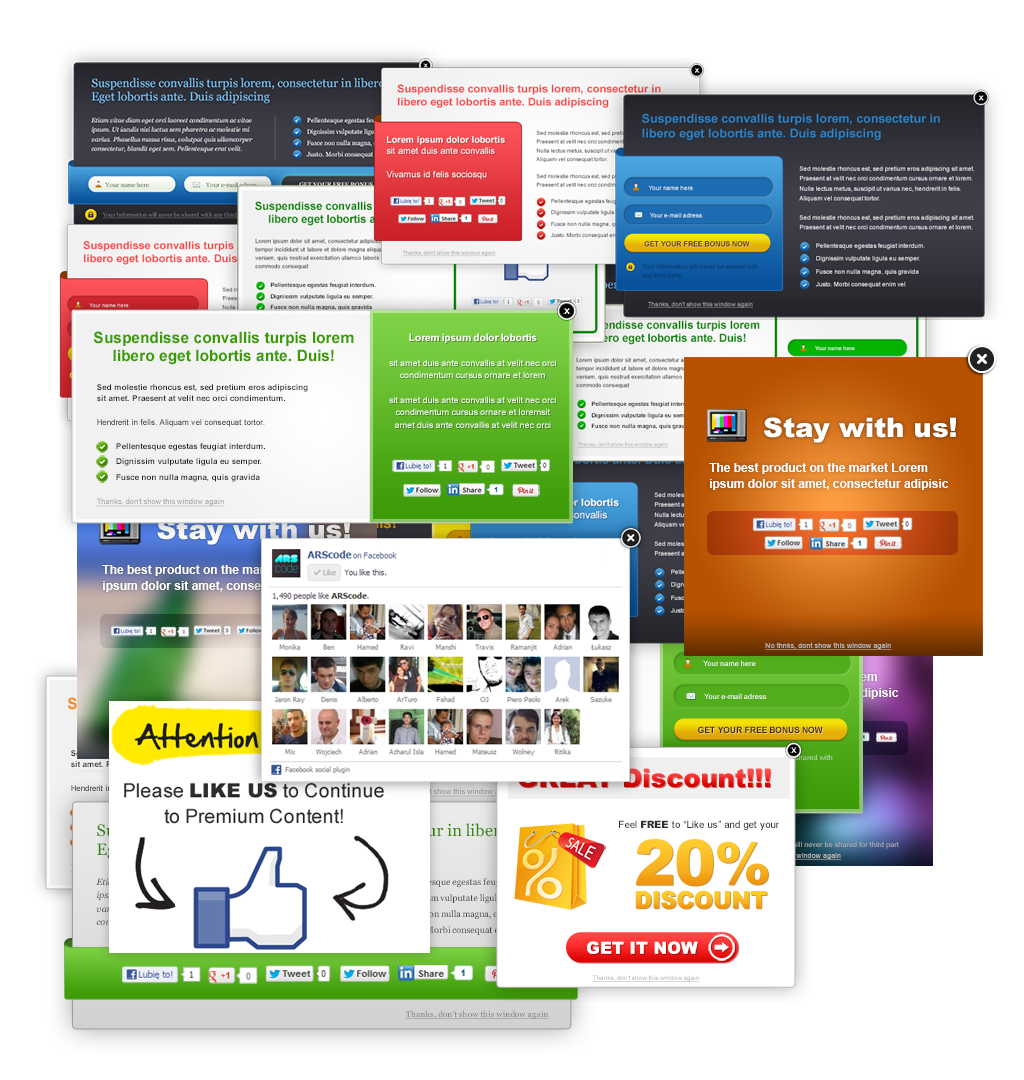
Okay, it's probably not that bad. But you get the idea.
It's easy to go overboard, and I get that. But as Social Triggers's Derek Halpern points out, going too far can actually become your conversion rate's worst enemy.
You should definitely focus on conversion, but don't get a death grip on it. Conversion is a long-term strategy, not a short-term win.
Now that you've understood the conversion mindset, let's take a look at how to convert all your traffic.
Publish the right content
If I had to pick a favorite form of marketing, it'd be content marketing.
Great content is wildly powerful. The converse is true too: horrible content is wildly destructive.
In fact, your blog can (and will) fail if you get the content wrong. If you create too much content, you'll fail. If you create content that's not relevant to your readers, you'll fail.
So it's imperative you get the content right.
First, you have to decide on the type of content you'll provide. There are many options to choose from: blog posts, webinars, and podcasts, to name a few.
How do you know which type of content is right for you? You have to know your audience. I know my readers are looking for thorough guides, and that's one of the many reasons I use blog posts.
On the other hand, there are people like Tim Ferriss who use podcasts as their medium of choice.
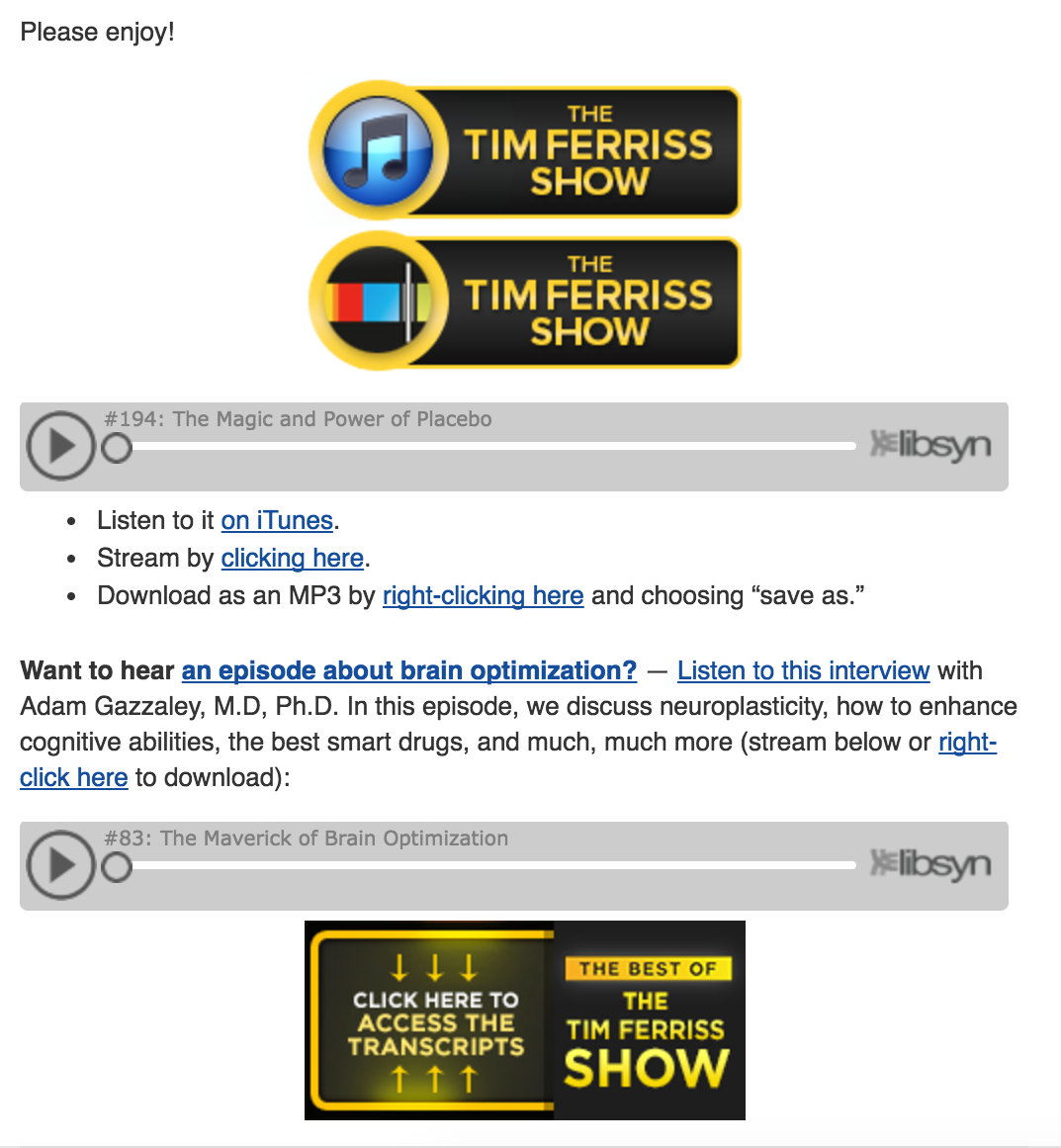
Tim knows his audience loves interviews with experts, and that's what he gives them.
The lesson: Study your audience until you know them as well as you know your friends. Find out what type of content they respond to the most.
You also have to get the length right. I've found that longform content works best. You might be surprised to know that 3000+ word blog posts get more traffic than shorter posts.
Make conversion easy (but not annoying)
If you want people to convert, you need to make that process easy. If your readers love your content but can't find an easy way to sign up for your list or buy your product, you'll lose out.
There are a few elements you have to get right if you want to boost your conversion rate:
1. Make an irresistible offer
First things first: If your offer itself doesn't amaze your readers, you'll get zero conversions.
To create an irresistible offer, you have to know what your readers want. Delve into your psychographics to find out what drives your audience and why they behave the way they do.
SumoMe's blog post called “The Definitive Guide to Content Upgrades” adds a sweet offer:
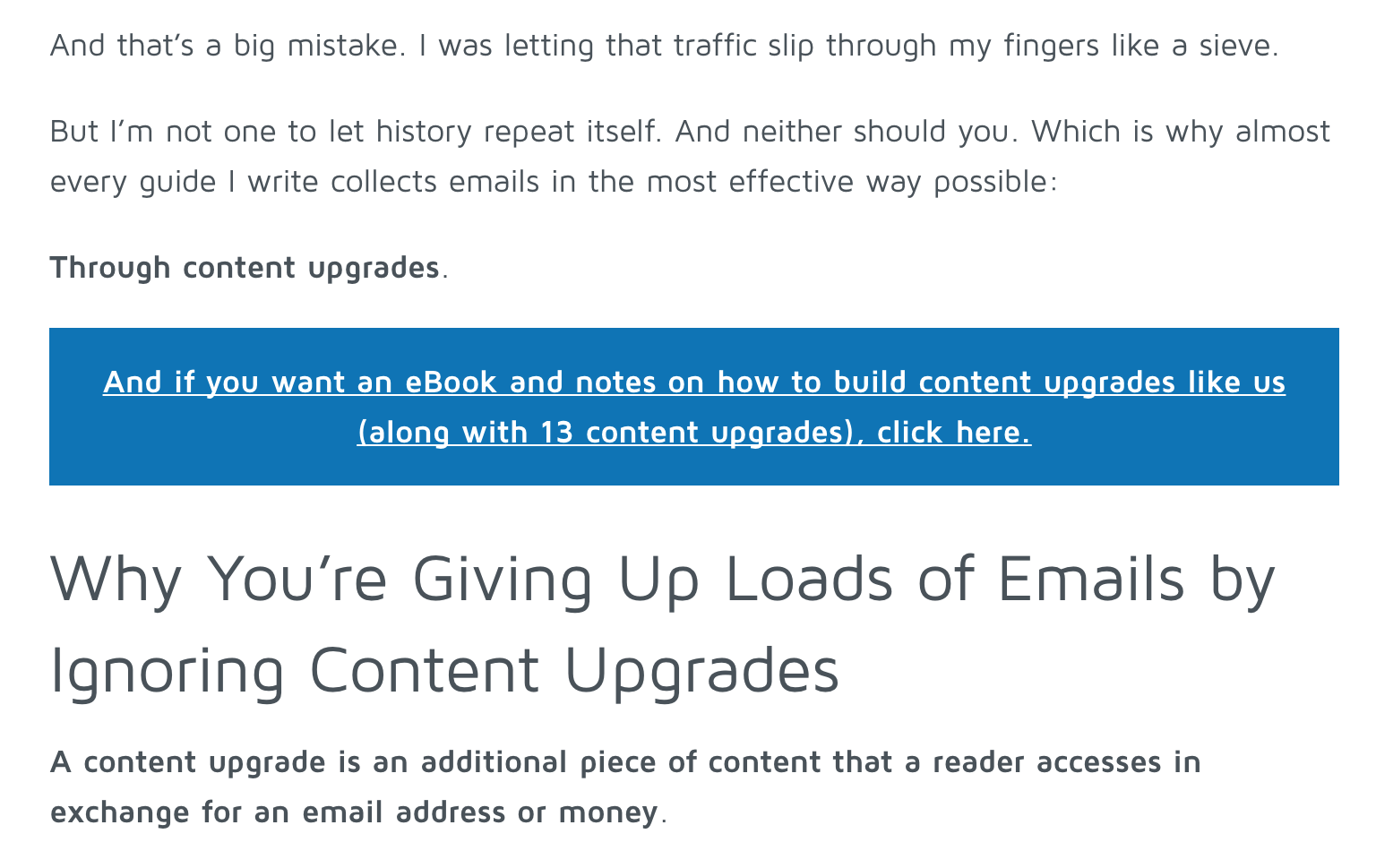
Everyone who's reading this post wants to learn more about content upgrades, so SumoMe offers a free e-book. It's specific, relevant, and valuable.
On the other hand, if your offer is not specific, relevant, or valuable, your readers will have no reason to take you up on it. Don't beat around the bush with general offers like a cheat sheet on being a better marketer. Your offer should be targeted specifically to your readers.
When you're working on creating an irresistible offer, make sure it's specific, relevant, and valuable. Your offers build the foundation on which you'll build your conversion.
2. CTAs (calls-to-action)
If your CTAs are boring, your conversion rate will be low.
One of the best ways to write a great CTA is to be specific. “Buy now” could refer to anything, but “download your free e-book” reminds the reader what they're getting.
Your CTA needs copy that's exciting. It should feel like you're inviting the reader on an adventure. It should not feel like you're selling something.
Optimizely uses a straightforward and effective CTA:
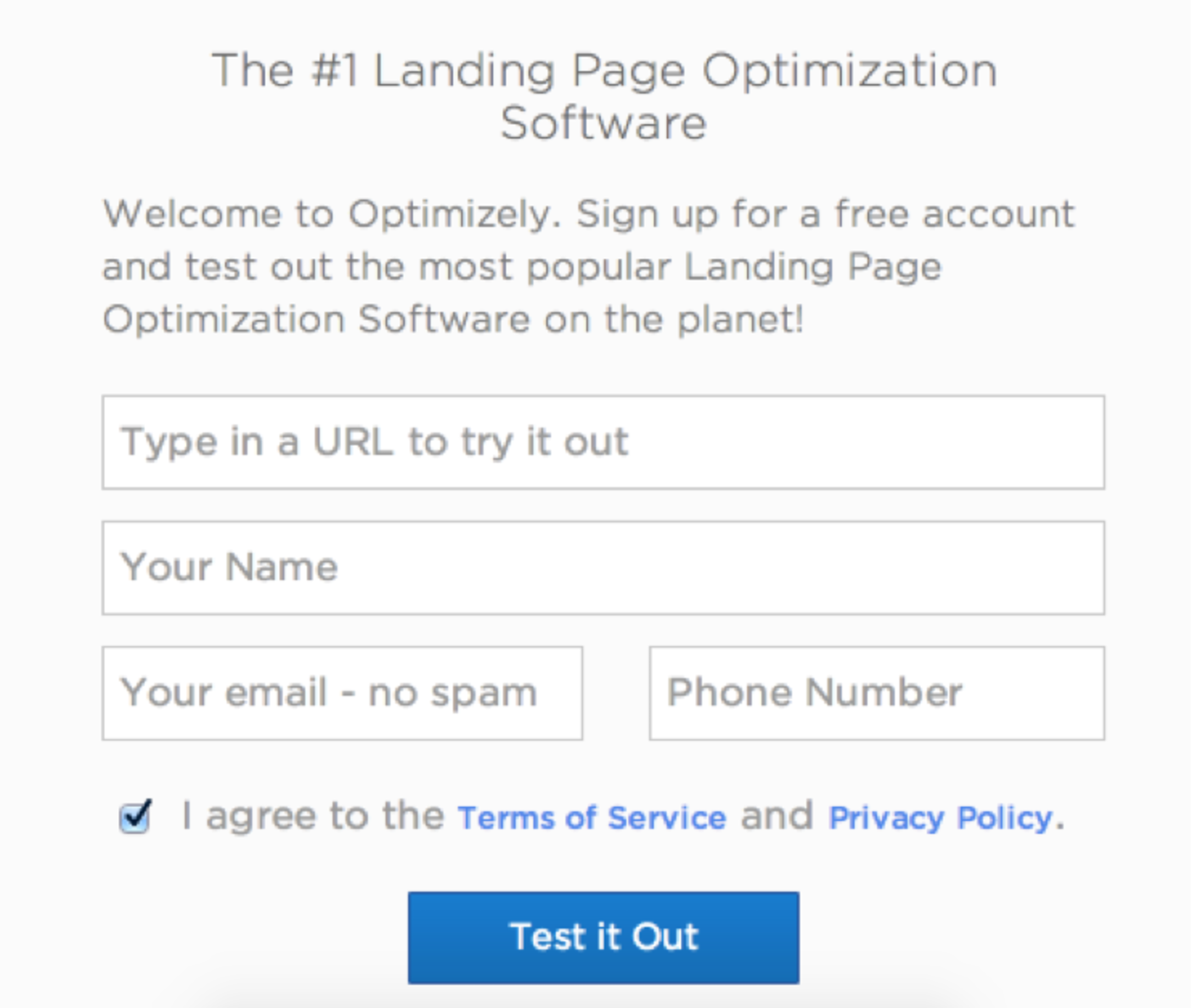
There's no hard sell here. It's an invitation to test out the software free. Plus, it's a breeze to fill out.
Design matters too. Your CTA needs to be highly visible so people can find it and click it. It's so simple, right? But many blogs get this wrong.
Brian Dean from Backlinko uses a yellow box for his CTAs:
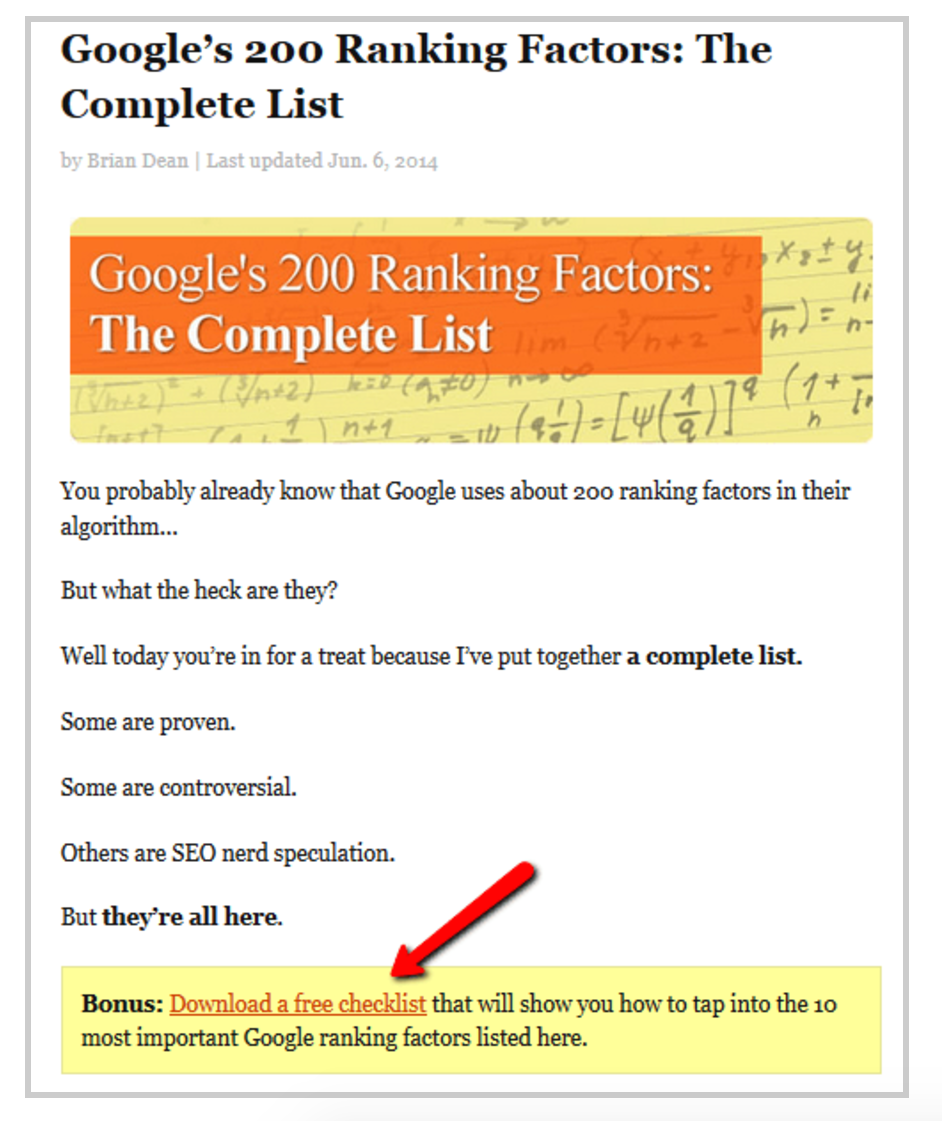
The yellow box works because your eye is naturally drawn to it. For Brian, that means higher conversion rates.
Find out what your yellow box is. Don't forget to A/B test to figure out what's working the best (and what you should ax).
Put in the time and effort to create an eye-catching CTA that engages your readers, and you'll be rewarded.
3. Popups
Quiz time: How are popups like Justin Beiber?
As Hunter Boyle of Aweber puts it,
You either love 'em, or hate 'em, but lately you see 'em everywhere-because they still pull in big crowds.
You might find popups annoying, but they work wonders. We successfully used popups on Kissmetrics to double our conversion rate.
Popups play a vital role in converting your traffic, but you shouldn't go overboard. By tastefully using popups, you can skyrocket your conversion rate.
First, you need to decide which type(s) of popups to use. The days of random popups are gone. Instead, opt for triggered popups.
Let's talk about two of my favorite types of popups:
- exit intent overlays
- scroll-triggered scrollboxes.
You're probably familiar with exit intent popups that appear when your mouse moves to close the tab. An exit intent overlay is a full-screen popup that appears when a user gets ready to leave the site.
Smartblogger uses an exit intent overlay with a cunning strategy:

This popup immediately engages the reader. Instead of being presented with just one option, you get two. And one of them has to be applicable to you. At the very least, it raised your eyebrows, right?
And here's the best part: There are two different lead magnets for the two answers.
You don't have to copy this popup, but I hope it gets you thinking about using exit intent popups. They perform well, but you have to put the work in.
Next up is scroll-triggered scrollboxes. These are the little boxes that pop up on the lower right-hand side of the screen. Usually, these popups appear after you've scrolled down the page.
For example, when you scroll to the bottom of any Crazy Egg post (like this one), you'll see this:
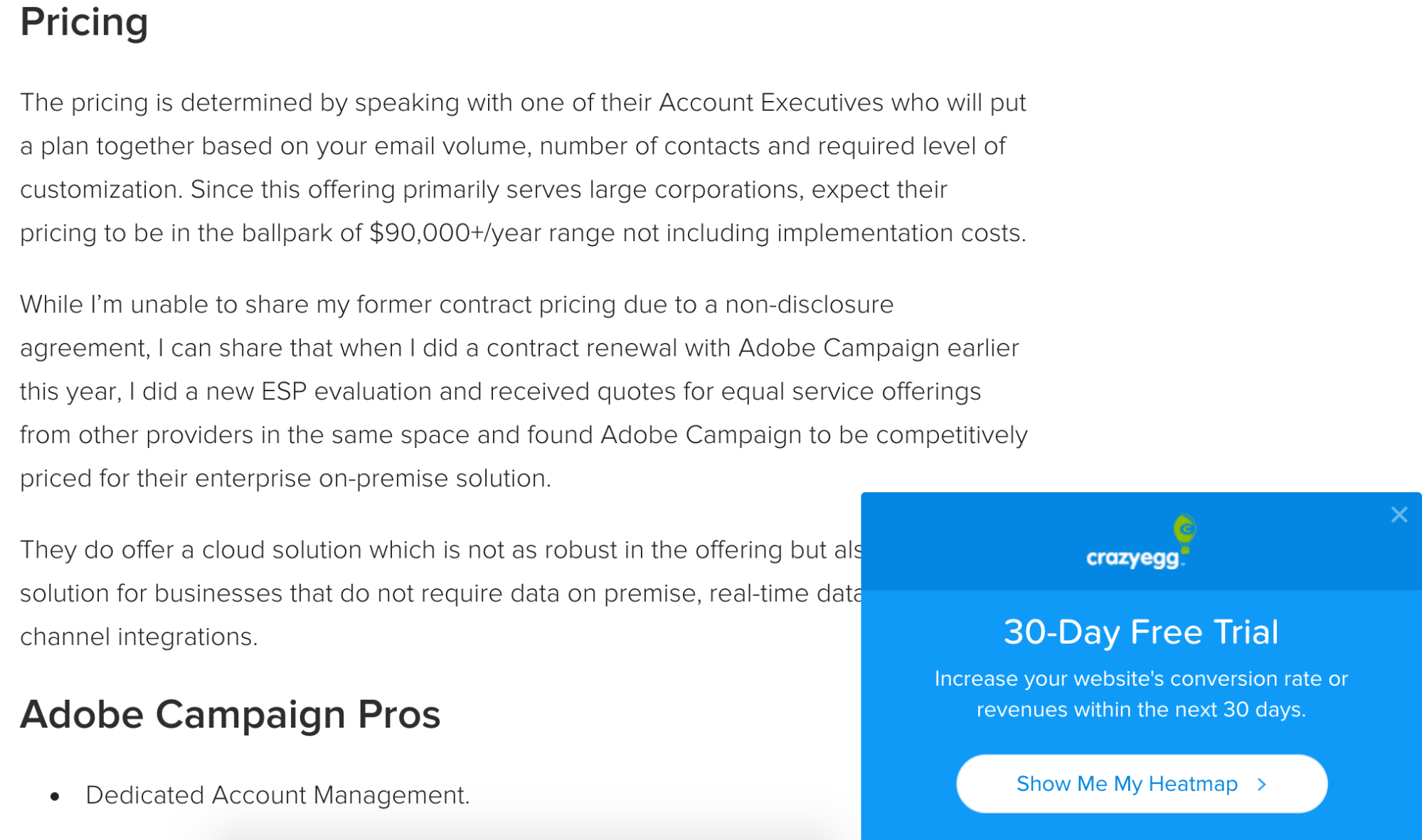
These are great because they're not intrusive. They take up a small amount of real estate, and they're far less annoying than random popups that cover up half the screen.
The most important takeaway here is that popups should not distract from the user experience of your site visitors. Don't cover up the content or make closing the popup difficult. Respect your readers.
Conclusion
You're probably drawing in plenty of traffic.
Remember, however: what matters most is what you're doing with that traffic.
Create an irresistible offer, and make it accessible to your visitors. People are willing to check out your offer, but it has to be worth their time. So, add as much value to your offer as possible.
I won't lie. Conversion optimization isn't a walk in the park. But it pays off.
And if you nail conversion, you'll have a bunch of satisfied customers in no time.
What are your biggest problems with converting traffic?
How to Get 100,000 People to See Your Blog Post

What would 100,000 views on a blog post mean to you?
Depending on the goals of your blog, it could mean thousands of new subscribers and fans.
But it could also mean new customers - big traffic means big exposure and big exposure means big growth.
We've been publishing content at Groove for the last five years. We've messed up a lot, we've learned a lot more and we've grown from nothing to over $300,000 in monthly recurring revenue through content marketing.
Today, our blogs are the single biggest driver of growth (as in, real money) for our business.
A couple of years ago, we published a post about how we successfully drove traffic to our blog. It outlined the step-by-step system that we used for influencer outreach.
That post, not surprisingly, has become one of our most popular. We still use the basic foundation of that old system today, but it's come a long way.
This is the updated version.
Below, we'll go through the entire “lifecycle” of a blog post, from idea generation to writing to publishing to promotion, to show you how to generate lots of traffic.
We'll use another one of Groove's most popular posts - “We Deleted Our Facebook Page. Here's Why.” - as an example.
Let's dig in.
1. Picking a topic: Go big
If your goal is to get 100,000 people to see your post, then you need to pick a topic that a lot more than 100,000 people are interested in.
What that includes:
- Painful problems that lots of people or businesses have
- Aspirational goals that lots of people or businesses have
- Controversial issues that lots of people or businesses are divided on
What that doesn't include, from a content perspective:
- Your product, service or sales pitch
- Hyper-niche problems or goals that tiny corners of your market have
There's huge potential in writing insanely targeted pieces, but if you want lots of traffic, start with a topic that already gets lots of traffic.
Think of a highway with thousands of cars on it. It's a lot easier to build an off-ramp and siphon some of that traffic off of the highway than to build a whole new unconnected road and try to get cars to drive to it.

How do you know you're picking a big enough topic?
Start with the problems that you know your market has (if you're lost, here are some questions to ask to get you started).
Then validate the idea by searching for it
Start with simple Google searches, trying different terms around your topic (think like your reader, and use the exact language that you've heard your market use).

It'll become clear to you pretty quickly whether it's a crowded market with tons of content written about it (good), or something that very few people write about and, therefore, care about (bad).
Validate further by using Keyword Planner
Just log in to Google's Keyword Planner tool and select “Search for new keywords.”

You don't need expert-level Keyword Planner skills here. Type some topic ideas into the “Your product or service” box, and click “Get ideas.”

This is what you're looking for:

Keywords around the exact topic you want to write about should add up to a lot more than 100,000 searches per month.
This is what you're NOT looking for, as you'll have a hard time scrabbling together 100,000 views:

Again, we're not going into advanced SEO here, and there's lots more you can do with tools like this.
But you don't need to be an SEO expert to get lots of traffic. This step is all about getting practical validation about the audience size for your topic.

You've got the traffic - now how do you convert it?
2. Writing the post: Be bold
Once you've picked a topic you want to write about, you can write your post.
There are three things that every post needs to be if you want to succeed in content marketing:
- Valuable: Can readers take your post and DO something with it to improve their current condition?
- Interesting: Does your content make reader want to keep reading from beginning to end?
- Unique: Does your content stand out from the rest of the content being written about that topic?
All three are “table stakes” for effective content marketing. But for the purposes of this post, where we're focusing on traffic, let's assume that you can handle making your post valuable and interesting… so let's focus on the third: being unique.
Imagine a choir singing a melody; everyone looks the same and sounds the same, so you can't really tell the difference between any two voices.

Now imagine Kool-Aid Man busting through the brick wall at stage left and belting out a tune that nobody in the choir had ever even considered before.

How can you be bold like Kool-Aid Man?
Approach the topic in a way that nobody else has before
The first step of which includes looking at how everyone else is approaching the topic.
In our case, there were hundreds of articles about how to write for your business' Facebook page, tips for promoting it, how to make sure that people saw it, what kinds of content to produce for it and so on. Everyone was part of the choir, talking about the best ways to approach Facebook for business.
We decided to be Kool-Aid Man and give our readers permission to not spend time on Facebook at all. Here's the post title we chose:

Facebook simply hadn't worked for us for lead generation as well as other channels had, so in the spirit of focusing our very limited resources on only the highest-ROI efforts that we knew would work, we decided to delete our Facebook page and not spend any more time on it.
We were happy that we did, and we thought that others could benefit from a bit of focus, too. And beyond that, we wanted to offer a reality check to remind readers that just because all of the “experts” talk about something, doesn't mean you have to do it.
And so we wrote the post, the one that busted through the brick wall and didn't look or sound anything like the choir.
Of course, when you write a post like this, a lot of people will disagree with it. Many will even be offended.
But a lot of people will agree, too. And the more worked up someone gets about your post, whether they agree with it or not, the more likely they are to share it with others.
So pick a side. The more contrarian, the better. And defend it vigorously.
3. Find distribution channels: Identify the gatekeepers
If you had 100,000 people on your email list, then getting 100,000 views wouldn't be that hard. But let's assume that you, like most people, don't have a list that big (yet).
Well, there are lots of people out there that do.
This step is driven by simple math: it's a lot more time-consuming to get your post in front of 100,000 people, one by one, than it is to put it in front of 50 people who will each want to share it with 2,000 others.
That's distribution strategy. It's the “influencer marketing” that has become a bit of a dirty word because so many marketers are doing it poorly.
Let's go over how to do it well.
First, identify the influencers (the gatekeepers to your 100,000 people)
This is the most time-consuming part of the strategy, but it's critically important. Skip it or skimp on it and you can kiss your traffic dreams goodbye.
This used to be an extremely painstaking process for us that involved hundreds of hours of Google research. Now it's just a pretty painstaking process that involves several hours of Google research, plus a few hours using BuzzSumo.
Here's what you do:
First, find as many content pieces as you can that have done well and that relate to your topic using BuzzSumo's topic search:

Next, click on “View sharers” for each post.

You'll get a list of influencers that shared the post:

This makes for a terrific place to start your outreach.
Get as many influencers as you can, cutting out the obvious dead ends (bots that curate content, fake accounts), and put them into a Google Sheet (here's the one we use - just make a copy and steal it).
Try to get your list to at least 100 great leads whose total audience exceeds 5 million people (that means that you just need to get in front of 2% of them successfully to get 100,000 readers!), and add to your BuzzSumo-sourced list with:
- Google research (search for the topic you're writing about, and see who's already written about it)
- Twitter search (same approach: see who Tweets about the topic you're covering)
- Quora (if the question that you're asking has been asked on Quora, see which influencers posted opinions)
- Influential members of online communities and platforms related to your market
Quick side note:
Content marketing is a long game, and you'll be a lot more successful if you view it that way. Nowhere is that more true than with influencer outreach.
You're a lot more likely to have success with influencers who know and trust you because you've put in the time to follow and read their content, share it with others and contribute thoughtful perspectives in their comments sections. These are efforts that pay off dramatically over time, and I recommend you begin blocking off an hour or two each week to do that with everyone whom you see as an influencer in your market.
That will increase your success with this next tactic exponentially, though it will still work if you haven't done this yet (it'll just be harder).
4. Tell influencers about your post: Stand out
The next step is to tell influencers about your post.
The approach that we've used (something we originally saw in a Derek Halpern video many years ago) rests on three key pillars:
- Take the time to make every outreach email deeply personal and honest: Mass emails are annoying and, often, useless. Nobody will want to build a relationship with you when it's obvious that you're sending them a canned outreach email. Personalize each email with an authentic reason as to why you're reaching out to this person.
- Never send your content in the first email: Almost everybody does this (“Here's my post, please share it”). Not only is it rude, but it makes you look like everyone else. If you don't understand why this is rude, read Permission Marketing.
- Ask for feedback, not promotion: Again, everyone asks influencers to promote their posts. Remember: don't be the choir. Ask them for something that's not only more valuable, but that they're probably more willing to give: their feedback.
Here's a script we use:

The “authentic” in “authentic reason” is key. Find a post that they've written before, and actually do something with it.
Example:
I loved your post about email marketing myths; I had no idea that Tuesday isn't actually the best day to send. Just shifted an upcoming campaign to Friday to see what happens :)
I know you're an expert on this, and I'd love to get your thoughts on a post I'm working on about some surprising results I found when A/B testing subject lines.
Do you mind if I send you a link?”
Now, one of a few things will happen:
- They'll ignore you. Cool, move on.
- They won't give you feedback, but they'll respond. In some cases, because you didn't do what 99% of marketers do (ask them to promote your post), they'll do you a solid and share your content.
- They'll give you feedback.
#3 is the absolute best outcome you could hope for, because not only do you get helpful feedback from an expert on the topic, but now they've invested time in the creation of your post. Now it's their post, too.
So when you incorporate your feedback and come back with a request to share, they'll be more than happy to help:

5. Find what works: Have fun with it
If you repeat this process across 100+ influencers, you will eventually get big traffic. In the example above, the post hit 100,000 unique page views around 80 days after publishing.
If you do this across 10+ different blog posts and different influencer markets, you'll get even more traffic over time. And if you do it for a long time, you'll turn your content into a significant and dependable source of new leads for your business. Because the first step to converting on-site visitors is getting them there in the first place.

You've got the traffic - now how do you convert it?
But you'll get the best results if you have fun with the process. Play with it and test different things at every step of the strategy:
- Choose topics that seem weird to you (but that have big audiences)
- Experiment with making your argument in different ways and formats (infographics, videos, etc.)
- Try different scripts and calls to action for your outreach emails
You won't break anything, I promise. The worst that you'll do is get a negative data point that you learn and grow from.
Viral content marketing is both art and science
As you can see, getting 100,000 readers takes both art and science.
On the art side, writing is important and you have to make an interesting, useful and unique case. And you have to pitch it to influencers in an empathetic and honest way.
But ultimately, the art gets you nowhere without understanding that achieving your 100,000-reader goal can be broken down using science: start with a much larger pool of readers, test different ways to build relationships with the gatekeepers, track what works and what doesn't and keep experimenting until you get there.
And don't forget that you won't win by joining the choir.
With Email Deliverability Comes A Huge Responsibility
I am privileged to manage global deliverability, across all Oracle Marketing Cloud properties. As you might imagine, I have the chance to speak to all kinds of customers, across all different customer life cycle stages.
One of the things that I find most interesting about customers in these different stages, is the way they understand how deliverability actually works, and what they can and can't do to change it.
The End Comes First
Let's start with the end-game first.
The reality is that you, as the sender, control and are responsible for your own deliverability. Deliverability in its simplest form boils down to some simple truths. Senders who deliver messages that are relevant to their customers, will see much higher engagement, inbox rates, and fewer complaints. It all seems pretty simple, and that's because it is in theory.
One of the misnomers that I hear with new clients on occasion, is something like this; “I have better deliverability now than at my old ESP”, or “I had better deliverability on my last ESP”. Both of these statements are, for the most part false. There are things that an ESP needs to have in place from an infrastructure perspective, that are 100% necessary.
You could be moving to or from a setup that may or may not have all of those table stakes elements. There's a natural reaction to want to look at deliverability numbers and forget the context of those numbers. Understanding that context, will take you much closer to that Utopian Deliverability state we're all looking to achieve.
When is it okay to compare numbers between two different sending origins? You can do it when the numbers are coming from the same base source. We all know that the warm-up period is critical in establishing your reputation with specific email receivers. During that time, it is important to make sure and put your best foot forward from an engagement standpoint.
Even as you do that, you will still see a significant portion of messages go to the bulk folder as ISPs evaluate your mailings. Comparing these warm-up numbers to another mailer with an established history, just doesn't add-up. The later-on comparison can also be problematic. Unless you are sending the exact same content to the exact same audience, (and why would you do that from 2 different systems?), it is not an apples-to-apples comparison.
The Deliverability Reality
Here's the reality of our space today. Unless you made a really bad choice of ESPs, you are probably covered from an infrastructure perspective. That means you are responsible for your own deliverability success.
The expertise and knowledge provided by ESPs is a differentiating factor between us, and can make a big difference in helping you reach your goals. Oracle Marketing Cloud puts a lot of emphasis on the warm-up period, and we offer incredible analytic tools such as our Deliverability Plus solution.
If you are in a place where you see better numbers from one source, think about the root cause instead of the blame game. What about audience and message? Are they the same, or are you doing better/different segmentation or messaging? Can you actually account for the difference in segmentation?
Even people who are in the same segment or demographic behave differently. It's important to stay focused on the end-game, and not get too caught up in comparisons that don't prove anything good or bad without a ton of extra analysis.
ESPs don't have “better” deliverability. They have experts and procedures that you may like and take advantage of, but at the end of the day, you are in charge of your deliverability.
Do you need help taking charge? Download the Email Deliverability Modern Marketing Guide today to gain best practices, ISP landscape, international regulations, and much more.
6 Ways to Celebrate the Holiday Season in Your Social Media Marketing

“On every world, wherever people are, in the deepest part of the winter, at the exact midpoint, everybody stops, and turns, and hugs, as if to say 'Well done. Well done, everyone! We're halfway out of the dark.'” -Doctor Who
Last night, I drove home from work in the dark. I hadn't stayed late putting the finishing touches on another devastatingly brilliant blog post. It was just that, after the long Thanksgiving weekend, the darkness has finally caught up with the end of the work day. And there's plenty more dark to go before the days get longer.
On the bright side, that means the holiday season is here. There are at least four major holidays and plenty of minor ones to go around.
All this festivity offers us unique chances to make a connection with potential customers. 'Tis the season for savvy social media marketing.
You don't have to drape your Facebook page in tinsel or string lights on your Twitter feed to catch the holiday spirit. In fact, the bigger, tackier celebrations are less likely to feel authentic, and more likely to alienate those who don't celebrate a particular holiday.
It's better to celebrate the holidays on social media the same way you do everything: With your audience's needs and wants firmly in mind.
Here are a few ideas for getting your brand into the spirit.
#1: Go Behind the Scenes
Your audience always wants to see the people behind the brand. During the holidays, those who are celebrating will enjoy seeing others celebrating, too. Snap candid shots of decorated desks, bedecked halls, and your annual office party.
Collect memorable holiday stories and favorite recipes from your co-workers, too, and share them with festive holiday portraits. Ugly sweaters and santa hats are optional, but encouraged.
#2: Encourage Your Audience to Share Holiday Photos
During the holiday season, most people's thoughts turn to happy childhood memories. We recall the warm glow of the menorah, or waking up early to see the presents under the tree–these memories are indelible. For kids born in the 70s and 80s, these precious moments were captured in pictures that look pre-Instagrammed.
Encourage your audience to share their favorite memories and photos with your brand. Create a branded hashtag you can use on Instagram to collect cool retro holiday photos and the stories that go with them.
#3: Shine Light on a Worthy Cause
One of the most powerful ways your brand can get noticed this season is to turn the spotlight away from the brand. Instead, highlight a charity that your brand can support, and offer a way for your customers to lend their support, too.
British retail chain John Lewis came up with a great way to support a good cause last year. Their annual holiday ad campaign centered on helping lonely senior citizens. On the campaign's landing page, customers could watch a heartstring-tugging video and donate to the charity.
#4: Focus on What Your Customers Need
This time of year consumers are drowning in a flood of holiday-related advertising. Everything from $500 cell phones to $40,000 cars are positioned as perfect holiday gifts. Every retail outlet is playing some variation of Christmas music non-stop.
It seems brands desperately want to put their customers in a holiday buying mood. But that's not what customers want. They want ways to deal with stress, or help finding the perfect gift, or a moment of silent reflection. B2B companies want help making their budget for next year, closing out 2016, making sure their customers feel appreciated.
Take some time to think about what special wants and needs your specific audience has this time of year. Better yet, ask a few of them. You could end up creating some powerful, useful content instead of more holiday dazzle. For example, last year on this blog we created an online retailer's checklist to help our audience.
#5: Sum up the Year
Not every consumer spins a dreidel or stuffs stockings this time of year. But the vast majority do celebrate the New Year. It's a time to look ahead and to reflect over the past year.
If Christmas carols or Kwanzaa lights don't suit your brand voice, New Year's is still a safe bet. Take the opportunity to tell your current and potential customers about your brand's year. Let them know how the company grew, what you learned, and most importantly how you are planning on treating them even better in 2017.
#6: Highlight What Unites Us
This season is about more than lighting candles and giving gifts. It's a celebration, as the quote up top reminds us, of being alive, being together, and being halfway out of the dark. Your brand can celebrate these ideals–family, togetherness, love–without committing to a single holiday in particular. Instead of singling out a specific group, you can remind everyone we're all in the same group. Regardless of race, creed, gender, or political leaning, we can all agree Nick Offerman is a national treasure:
Click here to view the embedded video.
What is your brand doing to make the holidays special for your customers? Let me know in the comments.
Stay tuned for pictures from TopRank Marketing's upcoming ugly sweater and cookie bake-off events. Sound like fun? We're hiring.
![]()
Gain a competitive advantage by subscribing to the
TopRank® Online Marketing Newsletter.
© Online Marketing Blog - TopRank®, 2016. |
6 Ways to Celebrate the Holiday Season in Your Social Media Marketing | http://www.toprankblog.com
The post 6 Ways to Celebrate the Holiday Season in Your Social Media Marketing appeared first on Online Marketing Blog - TopRank®.
